Unlocking the Willamette’s true potential
Travis Williams, January 8 2014
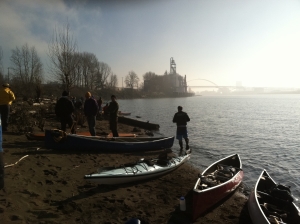 The Portland Harbor cleanup has been the subject of much attention lately, including here at Willamette Riverkeeper, and with good reason. There’s a lot at stake with the Superfund project, and we’ll need to continue to engage to get the best result for this vital stretch of the Willamette.
The Portland Harbor cleanup has been the subject of much attention lately, including here at Willamette Riverkeeper, and with good reason. There’s a lot at stake with the Superfund project, and we’ll need to continue to engage to get the best result for this vital stretch of the Willamette.But even as we focus on this complex issue, it’s important to remember other opportunities that can help unlock the tremendous potential of our river.
Here are four conversations I’d like to see launched in 2014:
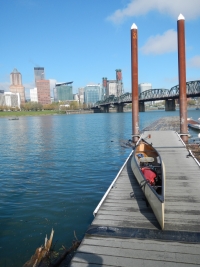
1) Accessing the water’s edge. Yes, we can stand over the Willamette River, in some areas, but we have too few opportunities to touch it, and get out on it. Good steps have been made to increase access over the past decade by the City of Portland, the Metro Regional Government and others. But we can continue to better to connect people to the river.
One idea: more trails to small beaches where one can launch a canoe or kayak, fish, and simply touch the water -- next to the Eastbank Esplanade, the Springwater Corridor, in Portland Harbor and beyond.
Another idea, one that’s been around for years: take down a portion of the “seawall” at Tom McCall Waterfront Park and replace it with a series of steps down to the water itself. Such an amenity could enable people to experience the river up-close, and can be combined with natural design elements that benefit wildlife. It is time to begin an action plan to make it happen.
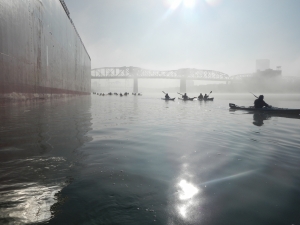 2) Restoring habitat in the heart of the city. We can do this today. Even small nodes of floodplain and healthy riverside habitat can provide tangible benefits for fish, birds and mammals. Throughout significant portions of the City, the riverside is rock and concrete, which does little for fish and wildlife. We can soften this hardscape at multiple urban locations, such as portions of the Bowl at Waterfront Park, and immediately improve shallow water habitat for threatened fish like Spring Chinook.
2) Restoring habitat in the heart of the city. We can do this today. Even small nodes of floodplain and healthy riverside habitat can provide tangible benefits for fish, birds and mammals. Throughout significant portions of the City, the riverside is rock and concrete, which does little for fish and wildlife. We can soften this hardscape at multiple urban locations, such as portions of the Bowl at Waterfront Park, and immediately improve shallow water habitat for threatened fish like Spring Chinook.3) Creating the Portland River Center. Imagine a facility on the banks of the Willamette that serves as a focal point for river-related interests. This space could be a gathering point for the public, enabling easy access to the river and space for human-powered craft such as rowing shells, canoes, kayaks, rowboats and more.
I envision a River Center that houses organizations that share a vision for a clean and healthy Willamette, from river-related retailers to businesses who simply wish to support the river. The Center could foster watershed education, from classes for all ages linked to Portland Public Schools, to research involving universities and the general public. In my view this potentially public/private partnership could increase our civic engagement in all things Willamette.
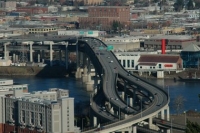 4) Moving Interstate-5. This is the big one on my list, but well worth a renewed conversation. It is time to begin to plan to move the Interstate 5 freeway away from the river, or to feed the freeway through a tunnel, or to cover a portion of it. Altering or moving the Marquam Bridge could also be part of the solution for an issue seen - and heard - by anyone who spends a few moments in the heart of the City.
4) Moving Interstate-5. This is the big one on my list, but well worth a renewed conversation. It is time to begin to plan to move the Interstate 5 freeway away from the river, or to feed the freeway through a tunnel, or to cover a portion of it. Altering or moving the Marquam Bridge could also be part of the solution for an issue seen - and heard - by anyone who spends a few moments in the heart of the City.The benefits would be extensive for the City of Portland. Instead of the current noise and vibration, we could realize an East Riverbank with wildlife habitat, public access and relative calm. Portland wouldn’t be the first to take on this huge logistical issue.
Seattle is making a massive improvement to its waterfront 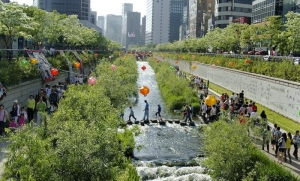 by removing the Alaskan Way Viaduct. And Seoul, South Korea removed five kilometers of freeway in the heart of the city, uncovering a small river now accessible to all.
by removing the Alaskan Way Viaduct. And Seoul, South Korea removed five kilometers of freeway in the heart of the city, uncovering a small river now accessible to all.
 by removing the Alaskan Way Viaduct. And Seoul, South Korea removed five kilometers of freeway in the heart of the city, uncovering a small river now accessible to all.
by removing the Alaskan Way Viaduct. And Seoul, South Korea removed five kilometers of freeway in the heart of the city, uncovering a small river now accessible to all.While I certainly place the elimination of Portland Harborʼs pollution first and foremost, there are tantalizing opportunities to make progress on these options as well. Letʼs move into 2014 with a vision of the future fueled by optimism, and alive with opportunity.

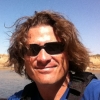 Travis Williams is Executive Director and Riverkeeper for
Travis Williams is Executive Director and Riverkeeper for
Add new comment